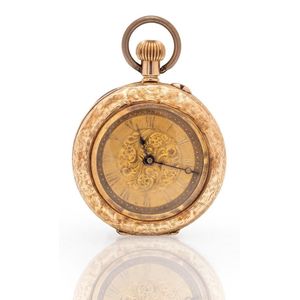1940 Swiss 9ct Gold Ladies Fob Watch, Small Size
A small 9ct gold open-face ladies fob watch Swiss circa 1940 3.1 cm diameter, 3.9 cm high. A small 9ct gold open-face ladies fob watch. Swiss Circa 1940. 9 carat gold open-face ladies fob watch. A small watch, 30 mm in diameter. Back, side and. bezel chased in a foliate pattern. Marked "9K" on the inside of the back cover, inner cover. gilt metal. Both covers bear the number 515967. Gold face with foliate decoration inside chapter ring. Gold Roman hour numerals on a matt. ground, minutes marked by dimples. Blued steel hands. Stem wind, cylinder escapement. Hands are set by pressing the knob on the side of the watch. near the stem. Provenance: Purchased from a second-hand store in Nambour Queensland, prior to 1972. Dimensions: 3.1 cm diameter, 3.9 cm high. Provenance: Purchased from a second-hand store in Nambour Queensland, prior to 1972.
You must be a subscriber, and be logged in to view price and dealer details.
Subscribe Now to view actual auction price for this item
When you subscribe, you have the option of setting the currency in which to display prices to $Au, $US, $NZ or Stg.
This item has been sold, and the description, image and price are for reference purposes only.
- Circa - A Latin term meaning 'about', often used in the antique trade to give an approximate date for the piece, usually considered to be five years on either side of the circa year. Thus, circa 1900 means the piece was made about 1900, probably between 1895 and 1905. The expression is sometimes abbreviated to c.1900.
- Bezel - On a clock or watch, the bezel is the metal frame into which the watch or clock glass is fitted. In clocks, the bezel may include a hinge and a flange, in effect a door to the face of the clock. In jewellery the bezel is a band of metal with a projecting lip that holds the gemstone in its setting.
- Foliate - Decorated with leaves or leaf-like forms.
- Carat - A carat (abbreviated "ct") is a unit of measurement used to describe the weight of a diamond or other gemstone, and separately is a unit of measurement used to describe the weight of precious metals such as gold,.
For gemstones, one carat is equal to 0.2 grams or 200 milligrams. The weight of a diamond is one of the Four Cs (along with cut, colour, and clarity) that are used to determine a diamond's value.
It is important to note that a diamond's weight does not necessarily correspond to its size. A diamond's cut, which affects how well it reflects light, can make a diamond of a lower weight appear larger than a diamond of a higher weight. Additionally, the carat is not the only factor to determine the value of a diamond, other factors such as clarity, colour and cut are important too.
In the gold industry, the purity of gold is measured in carats (abbreviated "ct"), with 24 karats being pure gold and lower carat numbers indicating a lower purity level. So, for example, 18 carat gold is 18/24 or 75% pure gold, and 12 carat gold is 12/24 or 50% pure gold. - Chapter Ring - A separate metal plate on the face of a clock, on which the numerals for the hours and sometimes parts of the hours, are displayed, usually wheel shaped and sitting on top of the dial plate. The chapter ring is often a feature of the clock and can be silvered or enamelled to stand as a contrast to its background. The hours are usually shown in Roman numerals, although in the late 19th and earlt 20th century, Arabic numerals became fashionable.
This item has been included into following indexes:
